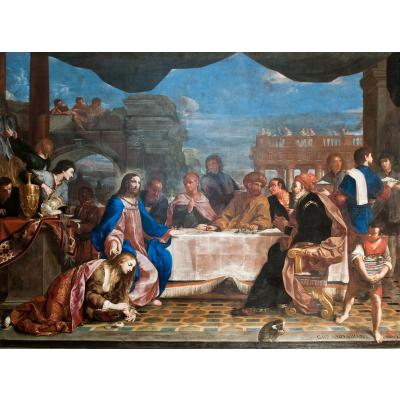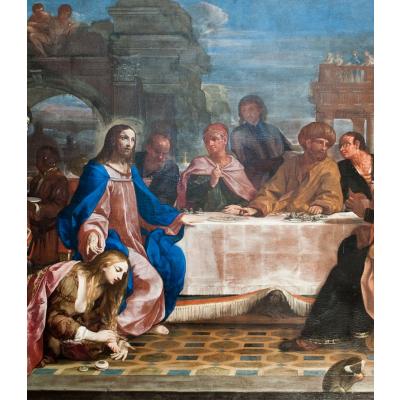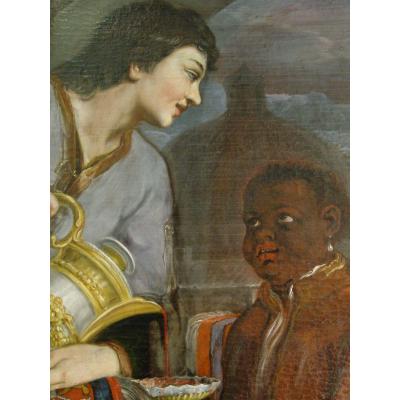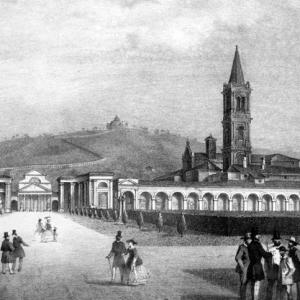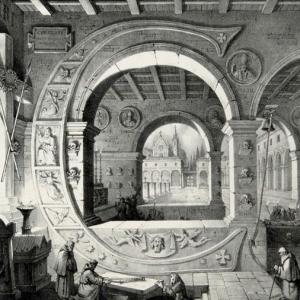Schede
The Supper in the House of Simon episode is reported in the Gospel according to Luke, at the end of chapter seven: One of the Pharisees invited him to eat at his home. He entered the Pharisee’s house and sat at the table. And behold, a woman, a sinner of that city, knowing that he was at the Pharisee’s house, came with a jar of perfumed oil and stopped behind huddled at his feet in tears and began to wet them with her tears, then dried them with her hair, kissed them and anointed them with perfumed oil. (Luke 7,36-39).
The large canvas (450 x 350 cm) is part of the Christological series commissioned by Don Daniele Granchio, the prior of Certosa, who from 1644 to 1658 convened some of the most important artists on the Bolognese scene for this undertaking. The importance of the commission was not underestimated by Sirani, who decided to sign and date the work in capital letters at the bottom right “GIO. AND. SIRANI 1652”, an unusual choice in the painter’s artistic career. Exactly ten years had elapsed since Guido Reni’s death, and while retaining the line of Renian classicism, Sirani adopts a more mature language with solemn tones and a vibrant palette in line with the neo-Venetian colourism in vogue in the 1650s in Bologna. In particular, Sirani looks to Paolo Veronese for the architectural setting with a three-dimensional effect and the bright shades of the drapery, which he associated with a refined rendering of the faces using delicate colours. Note especially the richly decorated cape and the chromatic vigour in the hair and face of Mary Magdalene, kneeling at Christ’s feet: a figure of very high emotional impact who seems to abduct the onlooker in a participatory act, as the common thread between the observer and the Christ figure.
Sirani remains loyal to biblical iconography by portraying Jesus at the table of Simon the Pharisee, while the “sinner” bathes Christ’s feet with tears, dries them with her hair and anoints them with perfumed oils. Meanwhile, before a richly crafted table Simon and the guests wonder why Christ allows himself to be touched by Mary Magdalene. A lobster is painted by the foot of the child bringing the dishes, on the right side of the work. At that time there was still no real distinction between different crustaceans and this element could be Sirani’s tribute to Don Daniele Granchio. From the restoration performed by Laboratorio degli Angeli, technical artistic data of particular interest emerge on a miraculously intact pictorial surface. We know from biographies that Giovan Andrea prepared his canvas with a rather thick imprimitura, mixing plaster with red-brown soil, glue and oil to make the mixture rich and smooth. As Malvasia states in his notes, before starting to paint the painter leaves the base to dry well to prevent the dark colours from being absorbed by the primer and losing consistence and vivacity. Removal of the thick layer of dirt from the painting has in fact revealed refined relations of colour, although the thick imprimitura and rich mixture have resulted in the natural formation of craquelure due to the ageing of the paints. In the sky in particular, where the large field of colour was created with liquid brush strokes and overlapped with veiling, a broad, pronounced horizontal "crack" is visible. Few after-thoughts emerge from the restoration, but one is significant: in a first version Christ’s face was half-face but while creating the work the painter decided on a three-quarter portrayal instead. The change is visible to the naked eye because the pale shades of the first version of the face re-emerged on the surface as the paint dried. Another correction was to the knees of Christ and the Pharisee, first close and then moved away. As Malvasia points out, this great painting establishes Giovan Andrea Sirani’s full confirmation in the artistic context of the 1860s, in a relationship aimed at integrating the Renian school classical culture into the more innovative Baroque solutions of his contemporaries.
Benedetta Campo

